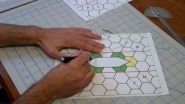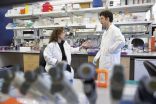(Press-News.org) The fruits and vegetables provided at school deliver an important dietary boost to low income adolescents, according to Meghan Longacre, PhD and Madeline Dalton, PhD of Dartmouth Hitchcock's Norris Cotton Cancer Center and The Hood Center for Children and Families. In a study released in Preventive Medicine, Longacre and Dalton found that fruit and vegetable intake was higher among low income adolescents on days when they consumed meals at school compared to days when low income adolescent were not in school. The opposite was true for high income adolescents who consumed fewer fruits and vegetables when school was in session, compared to summer months. While in school, all students consumed fruits and vegetables with similar frequency regardless of income level.
According to Longacre, "Innovation in school food offerings for kids has emphasized increased consumption of fruits and vegetables and it's working for low income kids, but the evidence shows that a different strategy may be needed to have the same positive effect on high income kids."
The Dartmouth research team, led by Dalton and Longacre, surveyed 1,885 NH and VT middle school students and their parents by phone. Using a unique longitudinal study design, they created a type of "natural experiment" by randomly allocating participants to be surveyed at different times of the year. This created comparable groups of adolescents who were, or were not, being exposed to school food by virtue of when they were surveyed. This facilitated comparison of fruit and vegetable consumption during the school months and over the summer. The survey asked the adolescents to recall fruit and vegetable consumption in the previous seven days. And no, fries don't count.
Previous studies demonstrated that kids from low income households eat fruits and vegetables less often than their high income peers, but whether school food mitigates the situation was an open question. By comparing consumption in and out of school by income group, Longacre and Dalton provide key data to inform national policy about resource allocation for meals in schools.
According to Dalton, "This study confirms that the national and regional school food programs provide an important source of fruits and vegetables for low income adolescents, which we know is a key indicator of dietary quality." Longacre adds, "Schools clearly have a role in providing healthy foods to children. Our data suggest that the most vulnerable students are benefitting the most from school food."
INFORMATION:
12/11/201
Funding for this study was from the National Institutes of Environmental Health Sciences, grant #RO1-ES014218.
Collaborators included: MR Longacre, KM Drake, LJ Titus, KE Peterson, ML Beach, G Langeloh, K Hendricks, MA Dalton
From the following institutions: Community Health Research Program, The Hood Center for Children and Families, The Geisel School of Medicine at Dartmouth, Lebanon, NH, USA; Greylock McKinnon Associates, Cambridge, MA, USA; Human Nutrition Program, School of Public Health, University of Michigan, Ann Arbor, MI, USA; Department of Nutrition, Harvard School of Public Health, Boston, MA, USA; Departments of Anesthesiology and Pediatrics, Dartmouth-Hitchcock Medical Center, Lebanon, NH, USA.
About Norris Cotton Cancer Center at Dartmouth-Hitchcock
Norris Cotton Cancer Center combines advanced cancer research at Dartmouth and the Geisel School of Medicine with patient-centered cancer care provided at Dartmouth-Hitchcock Medical Center, at Dartmouth-Hitchcock regional locations in Manchester, Nashua, and Keene, NH, and St. Johnsbury, VT, and at 12 partner hospitals throughout New Hampshire and Vermont. It is one of 41 centers nationwide to earn the National Cancer Institute's "Comprehensive Cancer Center" designation. Learn more about Norris Cotton Cancer Center research, programs, and clinical trials online at cancer.dartmouth.edu.
For more information contact Kirk Cassels at 603-653-6177.
PITTSBURGH--The 2013 Boston Marathon bombing motivated mass expressions of fear, solidarity, and sympathy toward Bostonians on social media networks around the world. In a recently released study, researchers at the University of Pittsburgh and Cornell University analyzed emotional reactions on Twitter in the hours and weeks following the attack.
The study is the first large-scale analysis of fear and social-support reactions from geographically distant communities following a terrorist attack. The findings show the extent to which communities outside of Boston expressed ...
Origami is capable of turning a simple sheet of paper into a pretty paper crane, but the principles behind the paper-folding art can also be applied to making a microfluidic device for a blood test, or for storing a satellite's solar panel in a rocket's cargo bay.
A team of University of Pennsylvania researchers is turning kirigami, a related art form that allows the paper to be cut, into a technique that can be applied equally to structures on those vastly divergent length scales.
In a new study, the researchers lay out the rules for folding and cutting a hexagonal ...
A CEO's natural sunny disposition can have an impact on the way the market reacts to announcements of company earnings, according to research from the University of British Columbia's Sauder School of Business.
The study shows that leaders' inclinations to express themselves with optimism carries over into their tone when disclosing company performance - a tendency that can create an uptick in stock price.
"Ours is the first study to look at the effect of how managers naturally convey themselves," says Sauder Assistant Professor Jenny Zhang, who co-authored the paper. ...
Senescent cells have a bad-guy reputation when it comes to aging. While cellular senescence - a process whereby cells permanently lose the ability to divide when they are stressed - suppresses cancer by halting the growth of premalignant cells, it is also suspected of driving the aging process. Senescent cells, which accumulate over time, release a continual cascade of inflammatory cytokines, chemokines, growth factors and proteases. It is a process that sets up the surrounding tissue for a host of maladies including arthritis, atherosclerosis and late life cancer. But ...
The ascetic and moralizing movements that spawned the world's major religious traditions--Buddhism, Islam, Judaism, Hinduism, and Christianity--all arose around the same time in three different regions, and researchers reporting in the Cell Press journal Current Biology on December 11 have now devised a statistical model based on history and human psychology that helps to explain why. The emergence of world religions, they say, was triggered by the rising standards of living in the great civilizations of Eurasia.
"One implication is that world religions and secular spiritualities ...
EMBARGOED for release Thursday, Dec. 11, 2014, at 12 p.m. ET
HOUSTON - (Dec. 11, 2014) - The ancient Japanese art of origami is based on the idea that nearly any design - a crane, an insect, a samurai warrior - can be made by taking the same blank sheet of paper and folding it in different ways.
The human body faces a similar problem. The genome inside every cell of the body is identical, but the body needs each cell to be different -an immune cell fights off infection; a cone cell helps the eye detect light; the heart's myocytes must beat endlessly.
Appearing online ...
Clinical trials to test the new drugs in patients should begin as early as 2015.
Existing drugs target faulty versions of a protein called BRAF which drives about half of all melanomas, but while initially very effective, the cancers almost always become resistant to treatment within a year.
The new drugs - called panRAF inhibitors - could be effective in patients with melanoma who have developed resistance to BRAF inhibitors.
The new study was funded by the Wellcome Trust and Cancer Research UK, and jointly led by scientists at The Institute of Cancer Research, ...
Scientists at the University of Southampton have found that the precise shape of an antibody makes a big difference to how it can stimulate the body's immune system to fight cancer, paving the way for much more effective treatments.
The latest types of treatment for cancer are designed to switch on the immune system, allowing the patient's own immune cells to attack and kill cancerous cells, when normally the immune cells would lie dormant.
In a study, funded by Cancer Research UK and published in the journal Cancer Cell, the Southampton team have found that a particular ...
PHILADELPHIA - (Dec. 11, 2014) - A team of scientists, led by researchers at The Wistar Institute, has found that an infection with herpes simplex virus 1 (HSV-1) causes rearrangements in telomeres, small stretches of DNA that serve as protective ends to chromosomes. The findings, which will be published in the Dec. 24 edition of the journal Cell Reports, show that this manipulation of telomeres may explain how viruses like herpes are able to successfully replicate while also revealing more about the protective role that telomeres play against other viruses.
"We know ...
The saga of the Osedax "bone-eating" worms began 12 years ago, with the first discovery of these deep-sea creatures that feast on the bones of dead animals. The Osedax story grew even stranger when researchers found that the large female worms contained harems of tiny dwarf males.
In a new study published in the Dec. 11 issue of Current Biology, marine biologist Greg Rouse at Scripps Institution of Oceanography at UC San Diego and his collaborators reported a new twist to the Osedax story, revealing an evolutionary oddity unlike any other in the animal kingdom. Rouse's ...


